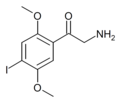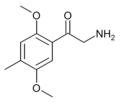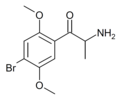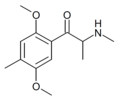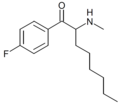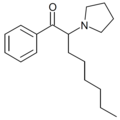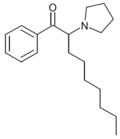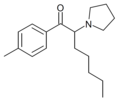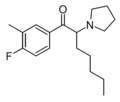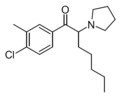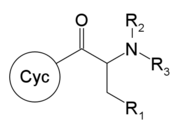A designer drug is a structural or functional analog of a controlled substance that has been designed to mimic the pharmacological effects of the original drug, while avoiding classification as illegal and/or detection in standard drug tests. Designer drugs include psychoactive substances that have been designated by the European Union as new psychoactive substances (NPS) as well as analogs of performance-enhancing drugs such as designer steroids. Some of these were originally synthesized by academic or industrial researchers in an effort to discover more potent derivatives with fewer side effects and shorter duration and were later co-opted for recreational use. Other designer drugs were prepared for the first time in clandestine laboratories. Because the efficacy and safety of these substances have not been thoroughly evaluated in animal and human trials, the use of some of these drugs may result in unexpected side effects.

Methylenedioxypyrovalerone (MDPV) is a stimulant of the cathinone class that acts as a norepinephrine–dopamine reuptake inhibitor (NDRI). It was first developed in the 1960s by a team at Boehringer Ingelheim. Its activity at the dopamine transporter is six times stronger than at the norepinephrine transporter and it is virtually inactive at the serotonin transporter. MDPV remained an obscure stimulant until around 2004 when it was reportedly sold as a designer drug. In the US, products containing MDPV and labeled as bath salts were sold as recreational drugs in gas stations, similar to the marketing for Spice and K2 as incense, until it was banned in 2011.

Substituted phenethylamines are a chemical class of organic compounds that are based upon the phenethylamine structure; the class is composed of all the derivative compounds of phenethylamine which can be formed by replacing, or substituting, one or more hydrogen atoms in the phenethylamine core structure with substituents.
These drugs are known in the UK as controlled drug, because this is the term by which the act itself refers to them. In more general terms, however, many of these drugs are also controlled by the Medicines Act 1968, there are many other drugs which are controlled by the Medicines Act but not by the Misuse of Drugs Act, and some other drugs are controlled by other laws.

α-Pyrrolidinopentiophenone is a synthetic stimulant of the cathinone class developed in the 1960s that has been sold as a designer drug and often consumed for recreational reasons. α-PVP is chemically related to pyrovalerone and is the ketone analog of prolintane.

Naphyrone, also known as O-2482 and naphthylpyrovalerone, is a substituted cathinone drug derived from pyrovalerone that acts as a triple reuptake inhibitor, producing stimulant effects and has been reported as a novel designer drug. No safety or toxicity data is available on the drug.
Substituted amphetamines are a class of compounds based upon the amphetamine structure; it includes all derivative compounds which are formed by replacing, or substituting, one or more hydrogen atoms in the amphetamine core structure with substituents. The compounds in this class span a variety of pharmacological subclasses, including stimulants, empathogens, and hallucinogens, among others. Examples of substituted amphetamines are amphetamine (itself), methamphetamine, ephedrine, cathinone, phentermine, mephentermine, tranylcypromine, bupropion, methoxyphenamine, selegiline, amfepramone (diethylpropion), pyrovalerone, MDMA (ecstasy), and DOM (STP).

Cannabicyclohexanol is a cannabinoid receptor agonist drug, developed by Pfizer in 1979. On 19 January 2009, the University of Freiburg in Germany announced that an analog of CP 47,497 was the main active ingredient in the herbal incense product Spice, specifically the 1,1-dimethyloctyl homologue of CP 47,497, which is now known as cannabicyclohexanol. The 1,1-dimethyloctyl homologue of CP 47,497 is in fact several times more potent than the parent compound, which is somewhat unexpected as the 1,1-dimethylheptyl is the most potent substituent in classical cannabinoid compounds such as HU-210.

6-(2-Aminopropyl)indole is an indole derivative which was first identified being sold on the designer drug market by a laboratory in the Czechia in July 2016.

2-Fluorodeschloroketamine is a dissociative anesthetic related to ketamine. Its sale and use as a designer drug has been reported in various countries. It is an analogue of ketamine where the chlorine group has been replaced by fluorine. Due to its recent emergence, the pharmacological specifics of the compound are mostly unclear, but effects are reported to be similar to its parent compound, ketamine.

N-Ethylhexedrone (also known as α-ethylaminocaprophenone, N-ethylnorhexedrone, hexen, and NEH) is a stimulant of the cathinone class that acts as a norepinephrine–dopamine reuptake inhibitor (NDRI) with IC50 values of 0.0978 and 0.0467 μM, respectively. N-Ethylhexedrone was first mentioned in a series of patents by Boehringer Ingelheim in the 1960s which led to the development of the better-known drug methylenedioxypyrovalerone (MDPV). Since the mid-2010s, N-ethylhexedrone has been sold online as a designer drug. In 2018, N-ethylhexedrone was the second most common drug of the cathinone class to be identified in Drug Enforcement Administration seizures.
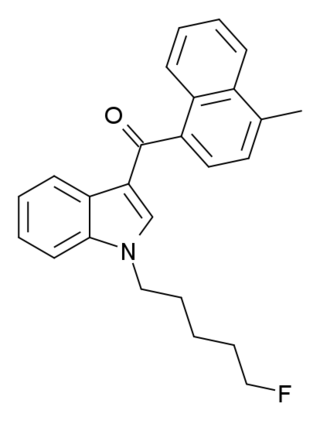
To combat the illicit synthetic cannabinoid industry many jurisdictions have created a system to control these cannabinoids through their general structure as opposed to their specific identity. In this way new analogs are already controlled before they are even created. A large number of cannabinoids have been grouped into classes based on similarities in their chemical structure, and these classes have been widely adopted across a variety of jurisdictions.

Flunitrazolam is a triazolobenzodiazepine (TBZD), which are benzodiazepine (BZD) derivatives, that has been sold online as a designer drug, and is a potent hypnotic and sedative drug similar to related compounds such as flunitrazepam, clonazolam and flubromazolam. It was first definitively identified and reported to the EMCDDA Early Warning System, by an analytical laboratory in Germany in October 2016, and had not been described in the scientific or patent literature before this. It is the triazole analogue of Flunitrazepam (Rohypnol). The addition of the triazole ring to the scaffold increases potency significantly, this is evident as flunitrazolam is reported anecdotally to be active in the microgram level. It is active at 0.1 mg.

Isobutyrylfentanyl is an opioid analgesic that is an analog of fentanyl and has been sold online as a designer drug. It is believed to be around the same potency as butyrfentanyl but has been less widely distributed on illicit markets, though it was one of the earliest of the "new wave" of fentanyl derivatives to appear, and was reported in Europe for the first time in December 2012.

Difludiazepam (Ro07-4065) is a benzodiazepine derivative which is the 2',6'-difluoro derivative of fludiazepam. It was invented in the 1970s but was never marketed, and has been used as a research tool to help determine the shape and function of the GABAA receptors, at which it has an IC50 of 4.1nM. Difludiazepam has subsequently been sold as a designer drug, and was first notified to the EMCDDA by Swedish authorities in 2017.

α-PHiP is a stimulant drug of the cathinone class that has been sold online as a designer drug. It is a positional isomer of pyrovalerone, with the methyl group shifted from the 4-position of the aromatic ring to the 4-position of the acyl chain. In a classic 2006 study of pyrrolidinyl cathinone derivatives by Meltzer et al. at Organix, the alpha-isobutyl derivative of pyrovalerone, O-2494, was found to have the highest potency in vitro as an inhibitor of the dopamine transporter of the alpha substituted derivatives tested; however, it was not until ten years later in July 2016 that α-PHiP was first identified as a designer drug, when it was reported to the EMCDDA by a forensic laboratory in Slovenia.

TH-PVP is a substituted cathinone derivative which has been sold as a designer drug. It was first identified by a forensic laboratory in Hungary in 2015, but has subsequently been found in numerous other countries around the world including Spain, Belgium, Poland, Turkey and Brazil. Pharmacological studies in vitro showed it to inhibit reuptake and promote the release of monoamine neurotransmitters with some selectivity for serotonin, but it failed to produce stimulant effects in animals, and has a pharmacological profile more comparable to that of sedating empathogens such as MDAI and 5-Methyl-MDA.

2-Methylmethcathinone (2-MMC), also known as ortomephedrone is a recreational designer drug with stimulant and euphoric effects. It is a substituted cathinone derivative, closely related to better known drugs such as 3-methylmethcathinone and 4-methylmethcathinone (mephedrone). It was first identified in Sweden in 2014, and has subsequently been reported in other European countries such as Poland and Spain.

N,N-Dimethylpentylone is a substituted cathinone derivative with stimulant effects, which has been sold as a designer drug, first detected in Sweden in 2014.



















































































































